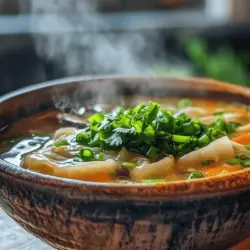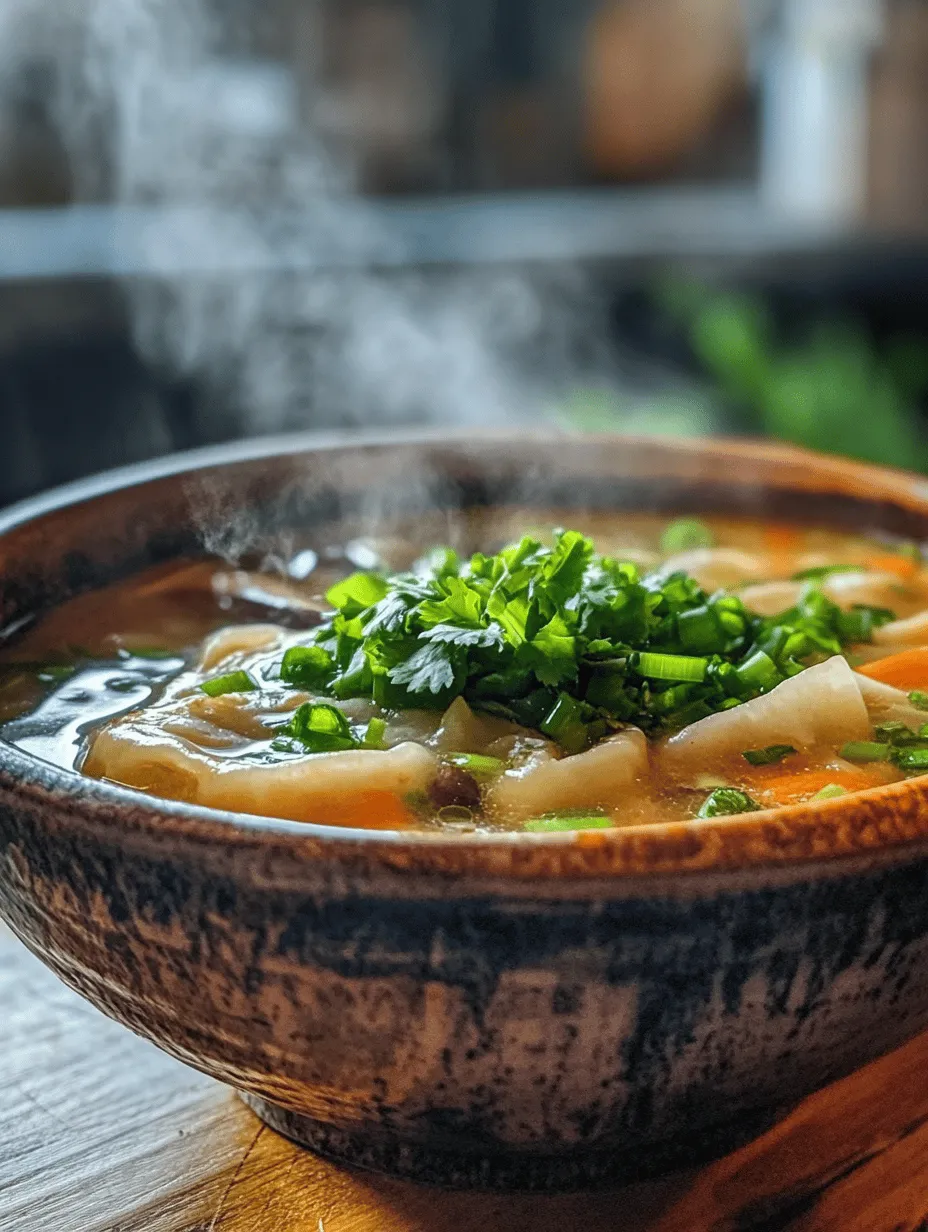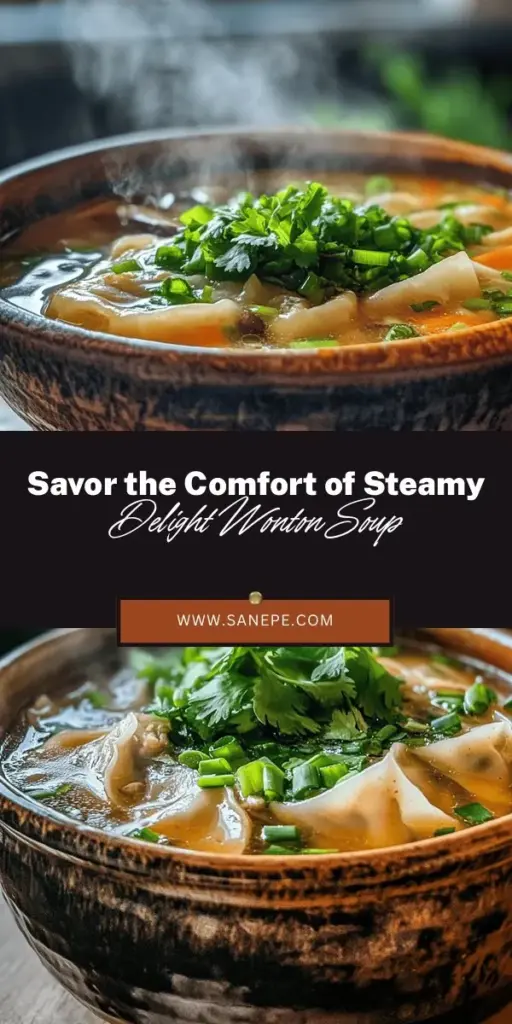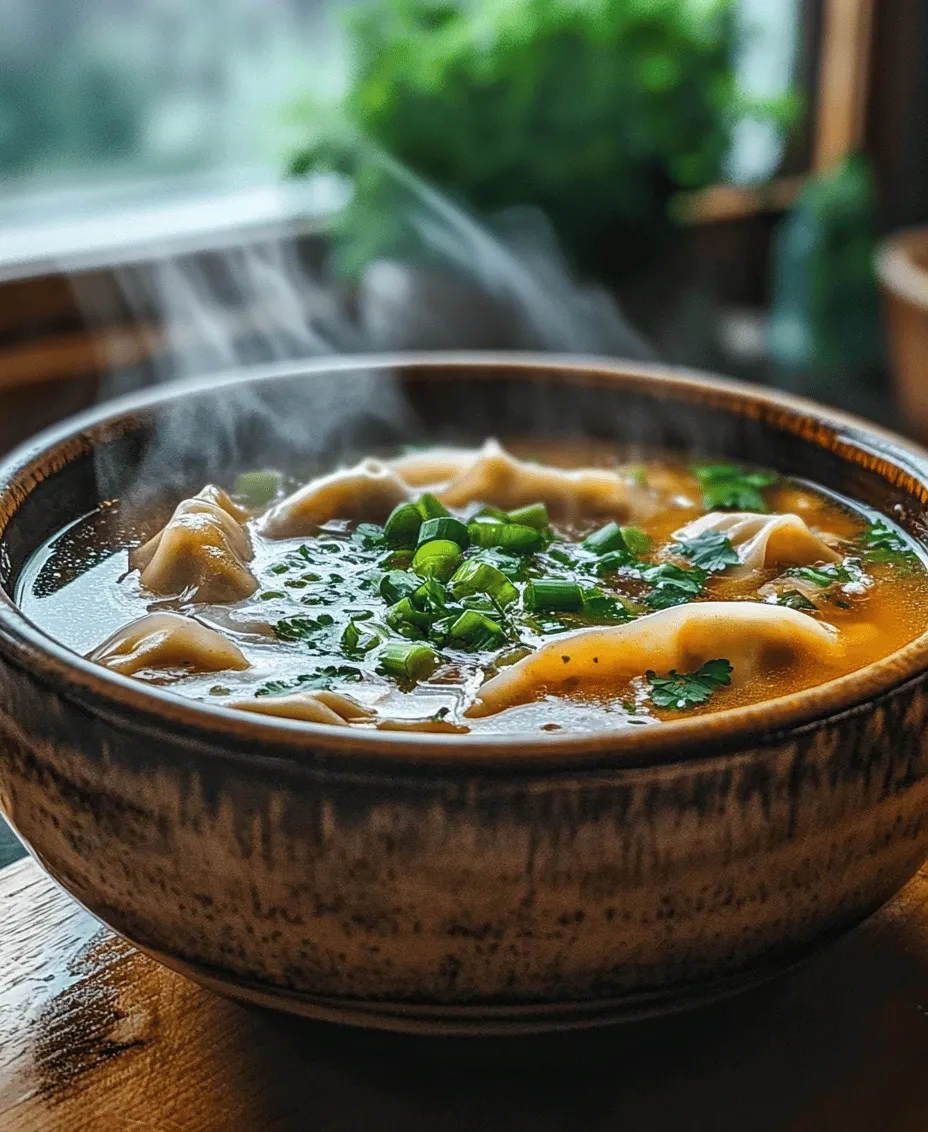Introduction
Wonton soup is a beloved dish that holds a special place in the hearts of many, especially within Asian cuisine. This delightful soup, often served as an appetizer or a light main course, features delicate dumplings filled with savory ingredients, nestled in a fragrant broth. Its significance goes beyond mere taste; wonton soup embodies comfort, warmth, and tradition, making it a staple in households and restaurants alike. The appeal of homemade wonton soup lies in its ability to bring people together, offering a wholesome and satisfying meal that warms both the body and soul.
Enter the Steamy Delight Wonton Soup—a recipe that highlights the perfect balance of flavors and textures. With tender wontons bursting with flavor and a broth that envelops each bite in warmth, this dish is more than just food; it is an experience. Whether you’re looking to impress guests at a dinner party or simply seeking a cozy meal for yourself, this wonton soup is sure to delight. In this article, we’ll explore the history of wonton soup, delve into its nutritional benefits, and guide you through the process of crafting this comforting culinary masterpiece.
Understanding Wonton Soup
Historical Background of Wonton Soup
The origins of wonton soup can be traced back to the Cantonese region of China, where it has been enjoyed for centuries. The word “wonton” itself translates to “swallowing clouds,” a poetic reference to the dumplings’ light and airy texture. Traditionally, wontons were served in a clear broth, highlighting the delicate flavors of the dumplings, and were often prepared during festive occasions or family gatherings.
As Chinese immigrants spread across the globe, they brought their culinary traditions with them. This led to various adaptations of wonton soup, each influenced by local ingredients and cooking methods. Today, wonton soup can be found in countless variations, from the rich, hearty versions popular in the United States to lighter, more herbal iterations found in Southeast Asia. Regardless of the locale, the essence of wonton soup remains the same—a comforting dish that brings joy and satisfaction to those who partake in it.
Common Ingredients and Variations Across Different Cultures
While the core components of wonton soup remain consistent, variations abound. The basic soup typically features wontons, a flavorful broth, and an assortment of vegetables. However, the types of meats used for the wonton filling can vary significantly. In some cultures, shrimp is favored for its sweetness, while others may use ground pork or chicken. Additionally, the broth may be enhanced with various herbs and spices, depending on regional preferences.
In Chinese cuisine, it is common to find wonton soup served with bok choy, a leafy green that adds both nutrition and texture. Meanwhile, in Vietnamese cuisine, a similar dish called “hoành thánh” incorporates wontons into a vibrant pho broth, showcasing the versatility of this ingredient. Regardless of cultural differences, wonton soup remains a beloved dish that celebrates the art of comfort food.
Nutritional Benefits of Wonton Soup
Wonton soup not only satisfies the taste buds but also offers various nutritional benefits. The primary source of protein in the dish comes from the meat used in the wontons, such as pork, chicken, or shrimp. This protein content is essential for muscle repair and overall health. Additionally, the inclusion of fresh vegetables—like bok choy, mushrooms, and green onions—provides vital vitamins and minerals, enhancing the soup’s nutritional profile.
Moreover, the broth serves as a low-calorie base that can be rich in nutrients, particularly if made from scratch. A homemade broth allows for better control of salt and preservatives, making it a healthier option than store-bought versions. The combination of protein, vegetables, and a well-crafted broth makes wonton soup not just a comforting dish, but also a nourishing one.
Ingredients Breakdown
Creating the perfect Steamy Delight Wonton Soup requires a thoughtful selection of ingredients. Each component plays a crucial role in achieving the desired flavors and textures. Below, we break down the main ingredients involved in the recipe.
Ground Meat Options: Pork vs. Chicken
When it comes to the filling for your wontons, the choice of ground meat can significantly affect the flavor profile. Ground pork is often the traditional choice, prized for its rich flavor and succulent texture. It adds a savory depth to the wontons that many find irresistible.
On the other hand, ground chicken offers a lighter option, appealing to those who prefer a milder taste or are looking for a leaner protein source. Depending on your preference, you might also blend both meats to create a unique flavor combination. Regardless of your choice, ensure that the meat is fresh, as this will enhance the overall quality of your soup.
The Role of Aromatics: Green Onions, Ginger, and Garlic
Aromatics are essential for building flavor in any dish, and wonton soup is no exception. Green onions, ginger, and garlic are the trifecta of aromatics that elevate the taste of your wontons and broth.
– Green Onions: These provide a mild onion flavor that complements the meat filling beautifully, adding a touch of freshness to the wontons. They can also be used as a garnish, enhancing the presentation of the dish.
– Ginger: Known for its warming properties, fresh ginger adds a zesty and slightly spicy note to the soup. It is believed to have numerous health benefits, including anti-inflammatory properties, making it an excellent addition to this comforting dish.
– Garlic: Garlic contributes a robust flavor that pairs well with the other ingredients. Its aromatic quality enhances the overall complexity of the soup, making each spoonful a delight.
Wonton Wrappers: Types and Where to Find Them
Wonton wrappers are the foundation of your dumplings, and selecting the right type is crucial for achieving the desired texture. Most wonton wrappers are made from wheat flour and are available in various thicknesses.
You can typically find fresh or frozen wonton wrappers in the refrigerated section of Asian grocery stores. If you’re unable to locate them, look for pre-packaged wonton wrappers in the international aisle of larger supermarkets. Some recipes even call for homemade wrappers, which can be made with just flour and water, although this requires an additional investment of time and effort.
Soup Base Ingredients
The broth is the heart of any wonton soup, and choosing the right base is essential. The two most common options are chicken broth and vegetable broth.
– Chicken Broth: For a traditional approach, using homemade chicken broth provides a rich, savory foundation that enhances the flavors of the wontons. The natural gelatin from the chicken bones adds body to the soup, making it even more satisfying.
– Vegetable Broth: If you’re looking for a vegetarian or lighter option, vegetable broth serves as an excellent alternative. It allows the fresh flavors of the vegetables to shine through while still providing a comforting base for the wontons.
The Importance of Fresh Vegetables: Bok Choy and Mushrooms
Fresh vegetables not only add color and nutrition to the soup but also contribute to its overall flavor. Bok choy is a popular choice, thanks to its crisp texture and mildly sweet taste. It wilts beautifully in the broth, adding a lovely green hue to the dish.
Mushrooms, whether shiitake, button, or enoki, introduce an earthy depth to the soup. Their umami flavor enhances the overall experience, making each bite more flavorful. Feel free to experiment with different vegetables based on your preferences or what is in season—carrots, snow peas, and spinach also make excellent additions.
Flavor Enhancers: Soy Sauce and Oyster Sauce
To truly elevate the flavor of your Steamy Delight Wonton Soup, consider incorporating flavor enhancers like soy sauce and oyster sauce.
– Soy Sauce: This essential condiment adds a salty, savory depth to the broth and the wonton filling. It is a staple in Asian cooking and provides a familiar umami flavor that ties the dish together.
– Oyster Sauce: Made from oyster extracts, this sauce offers a distinct sweetness and richness that can elevate the overall flavor of the soup. A little goes a long way, so use it sparingly to enhance your dish without overpowering it.
Making the Wontons
Now that we’ve explored the ingredients, let’s dive into the process of making the wontons, which is an integral part of creating your Steamy Delight Wonton Soup. The wonton-making process can be both fun and rewarding, providing a chance to connect with the culinary traditions of Asian cuisine.
Step-by-Step Guide to Preparing the Filling
1. Combine the Meats: In a large mixing bowl, combine your chosen ground meat with finely chopped green onions, minced garlic, and grated ginger. The aromatics will infuse the meat with flavor, creating a delicious filling.
2. Season the Mixture: Add soy sauce, oyster sauce, and a pinch of salt and pepper to the meat mixture. It’s important to taste and adjust the seasoning to achieve the desired flavor profile. Remember, this filling will be the star of your wontons, so don’t be afraid to be generous with the seasoning.
3. Incorporate Vegetables: For added nutrition and texture, consider adding finely chopped vegetables like bok choy or mushrooms to the filling. This not only enhances the flavor but also adds a delightful crunch.
4. Mix Thoroughly: Use your hands or a spatula to mix the filling until all ingredients are well combined. This step is crucial for ensuring that each wonton has a consistent flavor throughout.
Importance of Mixing the Filling for Flavor Consistency
Mixing the filling thoroughly is essential for achieving a harmonious flavor in each wonton. Unevenly mixed ingredients can lead to some dumplings being bland while others are overwhelmingly seasoned. By ensuring that all components are evenly distributed, you create a cohesive filling that delivers satisfying taste in every bite.
As you prepare your filling, keep in mind that wonton-making is an art form. The process can be meditative and enjoyable, especially when shared with friends or family. Enjoy the journey of crafting your Steamy Delight Wonton Soup, where every step brings you closer to a comforting culinary experience.
Tips for Folding Wontons: Techniques for Sealing and Shaping
Folding wontons is both an art and a skill that enhances the overall presentation and texture of your soup. Here are some effective techniques to master the art of wonton folding:
1. Preparation: Start with a clean, dry surface and keep your wonton wrappers covered with a damp cloth to prevent them from drying out.
2. Filling the Wontons: Place about a teaspoon of filling in the center of each wrapper. Be careful not to overfill, as this can cause them to burst during cooking.
3. Sealing the Edges: Moisten the edges of the wrapper with a small amount of water using your fingertip. This helps to create a seal.
4. Folding Techniques:
– Triangle Fold: Fold the wrapper in half diagonally to form a triangle, pressing the edges firmly to seal.
– Purse Shape: Bring the two opposite corners of the triangle together and pinch to form a purse shape.
– Crescent Shape: Alternatively, fold the wrapper into a triangle and then bring the two ends of the triangle together to create a crescent shape.
5. Final Touch: Ensure that all edges are sealed tightly to prevent any filling from leaking during cooking.
Variations on the Filling: Suggestions for Vegetarian or Seafood Options
While the traditional wonton filling typically includes ground pork or chicken, don’t hesitate to get creative! Here are some delicious variations:
– Vegetarian Filling: Use a combination of finely chopped mushrooms, spinach, tofu, and garlic. Add a splash of soy sauce or sesame oil for an umami kick.
– Seafood Filling: Combine minced shrimp and crab meat with fresh herbs like cilantro and green onions. A touch of ginger and lime juice can enhance the flavors beautifully.
– Mixed Protein: For those who can’t decide, consider a mixture of ground pork and shrimp. This combination provides a delightful texture and flavor.
Crafting the Soup
Preparing the Broth: Techniques for Achieving a Rich Flavor
The soup broth is the heart of your wonton soup. Follow these steps to create a flavorful base:
1. Start with a Quality Broth: Use homemade chicken or vegetable broth for the best results. If using store-bought, choose a low-sodium option to control the saltiness.
2. Infuse Aromatics: Sauté aromatics like garlic, ginger, and onion in a pot with a bit of oil before adding your broth. This step enhances the flavor profile significantly.
3. Simmering: Allow the broth to simmer gently with ingredients like scallions, mushrooms, and a splash of soy sauce or fish sauce for at least 30 minutes. This will deepen the flavors.
4. Strain the Broth: For a clear soup, strain the broth to remove solids before serving.
The Process of Adding Vegetables: Timing and Tips for Optimal Texture
Adding vegetables to your wonton soup not only increases its nutritional value but also its visual appeal. Here are tips for adding vegetables:
1. Choose Your Vegetables Wisely: Opt for quick-cooking veggies like bok choy, snow peas, and sliced carrots.
2. Timing is Key: Add the vegetables to the broth about 3-5 minutes before serving. This ensures they are tender yet still crisp.
3. Precook Hard Vegetables: If using denser vegetables such as carrots or broccoli, consider blanching them briefly in boiling water prior to adding them to the soup.
Cooking the Wontons: Signs They Are Ready and How to Avoid Overcooking
Cooking wontons requires careful attention to avoid overcooking:
1. Boiling Method: Bring the broth to a gentle boil before adding the wontons.
2. Cooking Time: Wontons typically take around 4-5 minutes to cook. They are done when they float to the surface and the wrappers become slightly translucent.
3. Avoid Overcooking: Remove them from the heat as soon as they are cooked to prevent them from becoming mushy.
Serving Suggestions
Presentation Tips for an Appealing Soup Bowl
Creating a visually appealing soup bowl can enhance the dining experience:
1. Layering: Start with a base of broth, then add wontons, followed by vegetables.
2. Color Contrast: Use colorful vegetables to create a vibrant presentation. A sprinkle of green herbs on top can elevate the look.
3. Garnish with Care: Use a light touch with garnishes to avoid overwhelming the dish.
Pairing Suggestions: What to Serve Alongside Wonton Soup
To complete your meal, consider serving the following alongside your wonton soup:
1. Spring Rolls: Crispy spring rolls complement the soup perfectly and add a nice crunch.
2. Rice Dishes: A side of steamed jasmine or fried rice can round out the meal beautifully.
3. Salad: A light Asian-style salad with sesame dressing can provide a refreshing contrast.
Garnishing Ideas: Fresh Herbs and Their Flavor Contributions
Garnishing your soup not only enhances its appearance but also adds flavor:
1. Cilantro: Adds a fresh, herbal note. Use whole leaves or finely chopped for a burst of flavor.
2. Green Onions: Sliced green onions sprinkled on top add a mild onion flavor and color.
3. Chili Oil: A drizzle of chili oil can provide a hint of heat for those who enjoy a spicy kick.
Nutritional Information
Breakdown of Calories, Proteins, and Key Nutrients Per Serving
Understanding the nutritional content of your wonton soup can help you enjoy it guilt-free:
– Calories: Approximately 250-300 calories per serving, depending on the filling and broth used.
– Proteins: Around 12-15 grams of protein, mainly from the wontons and any added proteins.
– Key Nutrients: Rich in vitamins A and C from the vegetables, along with essential minerals like calcium and iron.
Analysis of Health Benefits Derived from the Ingredients Used
Wonton soup is not just comforting; it also offers health benefits:
1. High in Nutrients: The combination of vegetables and lean proteins provides essential vitamins and minerals.
2. Hydration: The broth helps keep you hydrated, making it an excellent choice for colder months or when feeling under the weather.
3. Digestive Health: Ingredients like ginger can aid digestion and soothe the stomach.
Considerations for Dietary Restrictions (e.g., Gluten-Free Options)
For those with dietary restrictions, here are some considerations:
1. Gluten-Free Wrappers: Look for gluten-free wonton wrappers made from rice flour or use rice paper as an alternative.
2. Low-Sodium Broth: Choose low-sodium or homemade broth to control your sodium intake.
3. Vegetarian/Vegan Options: Ensure all ingredients, including sauces, are free from animal products.
Culinary Tips and Tricks
Storage and Reheating Instructions for Leftovers
If you have leftovers, proper storage is essential:
1. Storing Broth and Wontons Separately: To maintain texture, store the broth and wontons in separate containers in the refrigerator for up to 3 days.
2. Reheating: Reheat the broth gently on the stove and add the wontons just until heated through. Avoid boiling to prevent them from becoming mushy.
Freezing Wontons for Later Use: Best Practices
Freezing wontons can save time for future meals:
1. Flash Freeze: Arrange uncooked wontons in a single layer on a baking sheet and freeze until firm. Then, transfer them to a freezer bag.
2. Cooking from Frozen: Add frozen wontons directly to boiling broth without thawing. They may take an additional minute to cook.
Common Mistakes to Avoid When Making Wonton Soup
To ensure your wonton soup turns out perfectly, keep these common mistakes in mind:
1. Overfilling Wontons: Avoid overfilling to prevent them from bursting during cooking.
2. Rushing the Broth: Allow sufficient time for your broth to simmer and develop flavor; don’t rush this step.
3. Ignoring Cooking Time: Pay close attention to the cooking time of the wontons to avoid mushiness.
Conclusion
Preparing Steamy Delight Wonton Soup is a delightful culinary journey that combines the warmth of broth, the tenderness of wontons, and the crunch of fresh vegetables. The joy of sharing this comforting dish with family and friends makes it all the more special. Whether you stick to the traditional recipe or explore various filling options, this soup is bound to become a favorite in your household. So gather your ingredients, embrace the art of wonton folding, and indulge in the comforting flavors of this beloved dish. Happy cooking!



